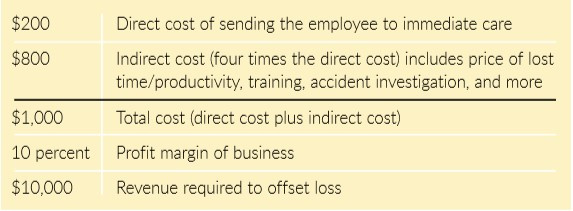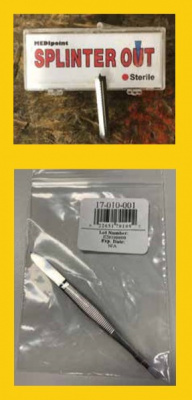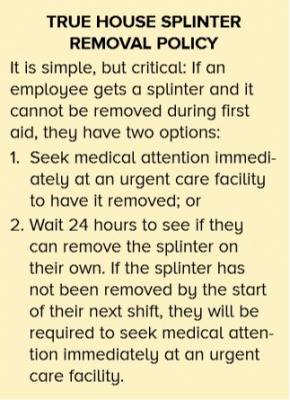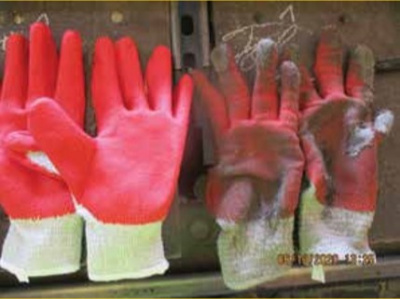The Little Things Matter
The Little Things Matter
Hands are the tool most used in your component manufacturing plant, so protecting them from injury or incident is critically important to maintaining employee productivity. From cuts and lacerations to sprains, strains, and broken bones, the potential for an injury exists in nearly every area of your production floor. According to the U.S. Department of Labor (DOL), injuries to hands accounted for nearly 25 percent of all lost-time industrial injuries—totaling 110,000 hand injuries annually.
One of the most devious injuries is the common splinter. While seemingly minor, a small splinter that goes untreated and becomes infected can cost you. For example, an employee gets a splinter that becomes infected:

Now think about how many splinters your team encounters every year. The thought of “spending” $10,000 for an infected splinter that could have been prevented is painful. Thankfully, splinter care is easy to handle with a few best practices.

Stock Up
Having the right tools on-hand to deal with a splinter is crucial. Mike Boswell, production manager for Plum Building Systems, LLC, suggests keeping a box of MEDIpoint Splinter Out splinter removers in your first aid kit. “We have found that these disposable tools work really well and our employees can grab one as needed on the production floor,” Mike explains. “Each Splinter Out comes in its own package, so they remain sterile, and then gets thrown away after a one-time use.” Splinter Out packs contain 10 or 20 individually wrapped lancets and, if you purchase multiple packs, can cost as little as 15 cents each. Hit up your safety equipment provider or order some from Amazon today.
Another tool to keep on hand is single-use tweezers. “We don’t want to have to worry about someone forgetting to disinfect between uses,” says John Moore, lean and safety coordinator for Franklin Building Supply’s truss and component facilities, “so this is an easy way to make sure everyone has a clean pair of tweezers if they need them.” At less than a dollar apiece, they are a very inexpensive insurance policy for keeping your team safe and splinter-free.
In addition, be sure to keep your first aid kits stocked for splinter removal with bandages, adhesive tapes, sterile gauze pads or rolls, antibiotic ointment, antiseptic solution or towelettes, and hand sanitizer.
Have a Clear Policy

Making sure employees understand the expectation if they get a splinter is more critical than it might seem. “Earlier this year we had an employee who got a splinter and was treated with first aid, but the splinter was not removed,” says Bobby Harrison, safety coordinator at True House Inc. in Jacksonville, Florida. “A month later, the same employee presented with an infection as a result of the splinter and needed medical attention. Thankfully, the treatment was simple and the employee recovered quickly.” Unfortunately, not every infected splinter has a simple resolution. Bobby says that another employee needed to have surgery and missed days away from work following a splinter-induced infection.
As a result, the team at True House decided it was time to take preventative measures and recently rolled out a new policy on splinters (see sidebar). “Under our new policy,” Bobby explains, “the chances of the employee sustaining an infection is greatly reduced. It should also limit the likelihood that a person needs to have surgery, days away from work, or a high-cost claim.”

Training Is Key
Protecting your employees from on-the-job hand injuries can seem overwhelming. Beyond the potential for splinters, there is a plethora of potential dangers in your plant, from sharp truss plates, nails, and staples, to the chemicals in preservative treated wood. However, you might be surprised by how many hazards you can combat with the least expensive, but likely most important, investment: training.
Regularly take time, during daily or weekly toolbox talks, to caution employees of the various exposures in the plant. Give examples of specific behaviors that help minimize risk. If you recommend (or require) gloves for certain jobs, remind your employees to take good care of their gloves and to ask for replacements when gloves are cut, torn, or worn through. In addition, engage your employees in the process, whether they are helping identify gloves that fit and perform well or leading peer-to-peer trainings on hand safety.
Do not underestimate the severity of a “simple” hand injury. Beyond the disruption to your employee’s life, production, and general morale, even minor injuries such as splinters have the potential to really affect your bottom line.
For more tools, tips, and tricks, watch the SBCA webinar, “Best Practices for Hand Safety in Component Manufacturing,” and learn how Mike, John, and Bobby protect the most important tools in their plants.

